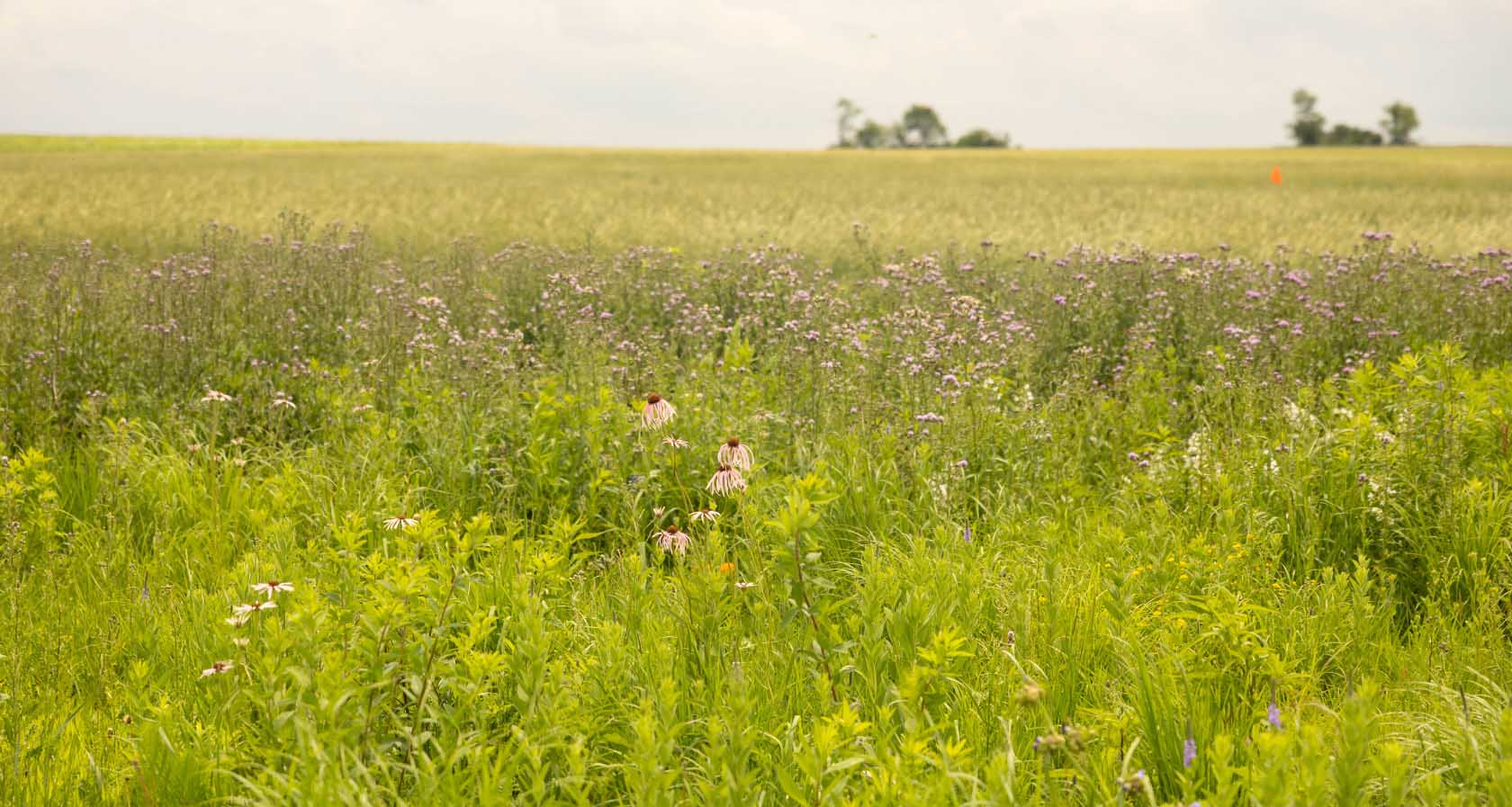
(Photo: Iowa Soybean Association / Joclyn Kuboushek)
Mighty Prairies: Big impact from small plantings
August 5, 2025 | Brandon Iddings
Key takeaways:
- Native prairie plantings have many soil, wildlife and downstream benefits.
- Small unproductive areas of farm ground could provide economic, environmental and recreational value if seeded to native prairie.
- Cost-share opportunities are available to help farmers get started.
Fields of green soybeans and corn line the highways and byways throughout Iowa. Every few miles, passersby might see a flash of different colors. These areas are often native prairie fields, filled with flowers and grasses often in shades of yellow, purple, pink, white and green.
What you don't see in these areas is the quiet work of these vibrant wildflowers, improving soil health, reducing soil erosion, enhancing water infiltration, water quality protection, carbon sequestration and providing habitat for pollinators and other wildlife. These benefits add value to your farming operation in a multitude of ways. According to Iowa State University's Natural Resource Ecology and Management (NREM), converting 10% of your unproductive or unprofitable acres to prairie can reduce sediment runoff by 95%. This conversion can reduce total phosphorous and nitrogen lost through runoff by up to 90%, according to NREM. In the last two years the Iowa Soybean Association (ISA) has worked with 35 landowners to restore 275 acres of native prairies from both unproductive and unprofitable crop acres and low diversity scrub ground
not in production.
In these 275 acres we have reduced nitrogen loss by 6,552 pounds per year and phosphorus by 269.4 pounds per year. These native prairies can have a huge benefit to farming operations, especially with cost-share programs like Conservation Reserve Program, and the Science-based Trials of Rowcrops Integrated with Prairie Strips (Prairie STRIPS) program.
Explore cost-share options
Cost-share opportunities help establish these areas and receive a yearly per acre payment comparable to your crop yields or rent payments, depending on Corn Suitability Rating (CSR). Additionally, native prairie plantings can help sequester carbon long term. When prairie grasses grow and die, they establish deep roots that create a carbon reservoir underground. This buildup of carbon over time can enhance these less profitable and less productive acres, making them more profitable and productive in the future.
Discover recreational value
There are also recreation benefits in these areas, as they tend to be suitable habitats for upland birds like pheasants and quail, and bedding and food sources for deer. These areas are also home to many native flowering plants that benefit many species, including the monarch butterfly and the endangered rusty-patched bumble bee.
Variety of benefits
Small areas of pollinator plantings can provide a range of benefits, including reducing herbicide drift and runoff, which helps protect surrounding ecosystems and wildlife. These practices support productive agriculture by promoting healthy soils and fostering beneficial insect populations.
Some effective strategies include planting prairie or buffer strips 15 to 30 feet wide, which can trap herbicide runoff and reduce drift. These border plantings also help control erosion and expand habitats for pollinators and other wildlife.
Other helpful conservation practices include using cover crops, conservation tillage, terraces, tile drainage, windbreaks, natural buffers near sensitive areas, specialized spray nozzles, lower spray heights and adjusting applications based on wind speed. These approaches contribute to a healthier landscape while supporting
long-term agricultural productivity.
Rethink unproductive areas
When harvesting this fall, watch the yield monitor for unproductive areas and consider how that small area could have exponential benefits to the rest of the field. These often small and overlooked areas, if converted to a native prairie planting, could provide value to you economically, recreationally and environmentally.
Interested in seeing what ground might be suitable to establish native prairie to have the most benefits? Contact me at biddings@iasoybeans.com.
Written by Brandon Iddings.
Back